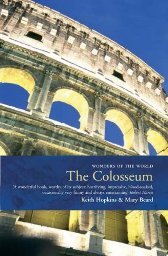
Surely it must be a basic rule of archaeology and history that you can’t generalise from one small archaeological remain, one single excavation, or one building – in order to understand a whole society. But it must be an equally important rule, that you can say a lot about a society from what it has left behind. This book, along with a couple of others in the series including Mary Beard’s great one on The Parthenon in Athens, attempts to give the best round-up of accepted wisdom about some of the world’s greatest ancient buildings and how they fit into the ancient world.
The Colosseum has long been a building that has represented the power of ancient Rome. It is a building that has been the backdrop to many films and novels (and the authors give us a taste of some of these), has inspired poetry (Byron in particular) and fired the imagination of many of those who’ve been there (including Hitler and even ancient rulers themselves who made it to Rome).
It’s also a place with many myths about it. For centuries it was believed to be a place of Christian martyrdom and the writers take care to demonstrate how this wasn’t true. The myths aren’t just ancient – most modern day films (and tour guides) make some mistaken assumptions.
In sorting the fact from the fiction, we learn some surprising stuff. For instance, for much of the Middle Ages, the building was a ruin. It’s true purpose forgotten by those living in the Rome. The authors go to great lengths to use available historical data to work out how many gladiators must have fought in the arena – the answer, contrary to the vision painted by Ridley Scott’s Gladiator, is very few. Gladiators turn out to be highly expensive to train and keep – too expensive to risk in the arena.
We also learn how the Colosseum was built – and I was surprised to learn (as were archaeologists) about the complex drainage systems below the ground. This was an Imperial building built to last (with a price tag that approached £29 million of today’s money) and modern day archaeologists still have many unanswered questions.
Even if you’ve been to Rome and walked the passageways of the Colosseum, this book will teach you a lot and if you’re lucky enough to be returning this summer, it’ll give you much more stuff to look at that you missed the first time.
No comments:
Post a Comment